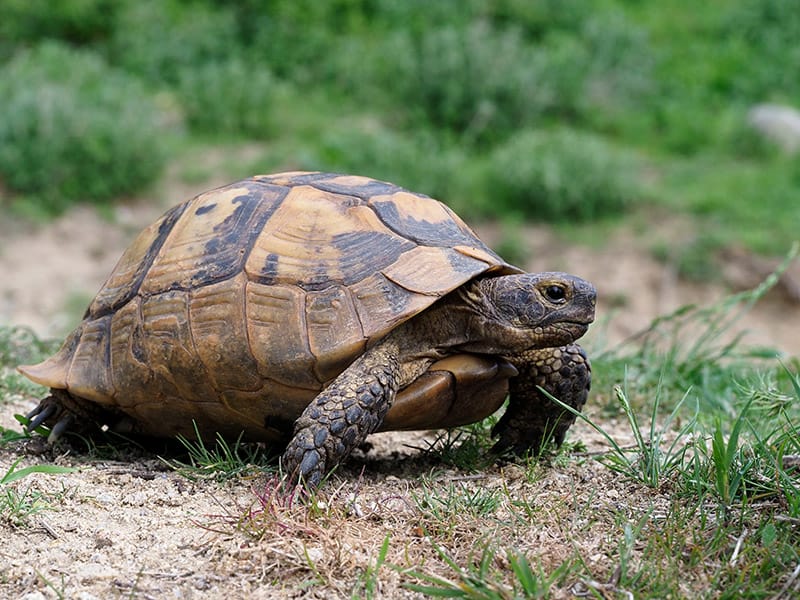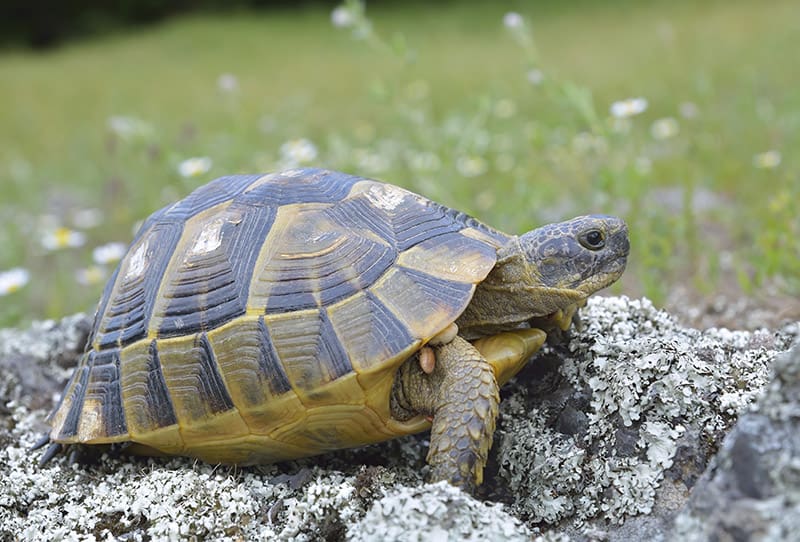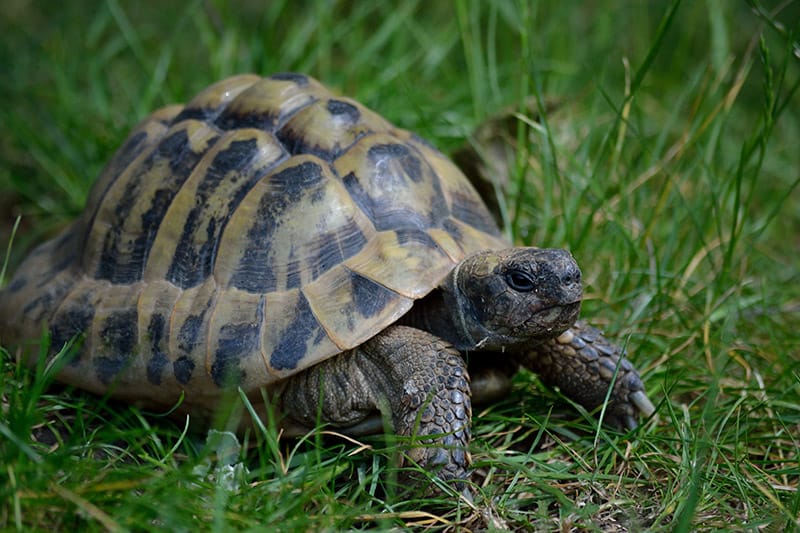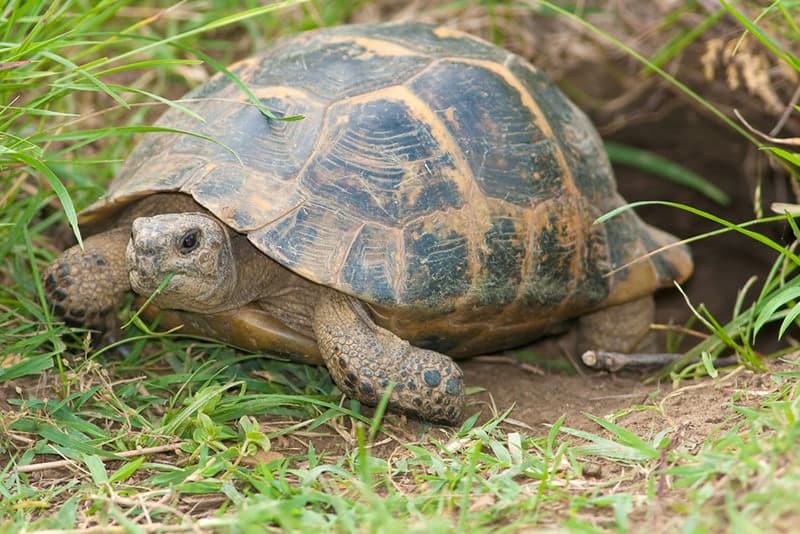Newly introduced into the American market in the summer of 2001, the pretty Spur-Thigh Tortoise shown above is known as the “Golden” Greek Tortoise!
The Greek Tortoises or Spur-Thigh Tortoises can be highly variable in size and color, as well in their care requirements. This is because their places of origination cover a huge geographic range on over three continents. Consequently, there are varying environments that these tortoises have adapted to, producing a large number of varieties. There are currently at least 20 published subspecies with new ones constantly being discovered.
These tortoises are still primarily wild-caught, so can harbor parasites and have other stress and environment-related problems. As they are also prone to dietary and respiratory illnesses, they are not a good beginner tortoises. They are best kept by more advanced keepers able meet their husbandry requirements. These needs vary and are dependent upon the environment where the individual tortoise originated. Generally very shy, the Greek Tortoises usually become more outgoing as they get used to their keeper’s activities, but they will continue to look for places to hide or bury themselves..
- For more information see: Selecting and Caring for Your Turtle or Tortoise
Scientific Classification
| Kingdom: | Animalia |
| Phylum: | Chordata |
| Class: | Reptilia |
| Order: | Testudines |
| Family: | Chelidae |
| Genus: | Testudo |
| Species: | graeca |
Distribution
Greek Tortoises or Spur-Thigh Tortoises were described by Linnaeus in 1758. They are found in southern Spain, Eastern Europe, Northern Africa, and parts of Asia especially the Middle East. They are found in a variety of environments from seashore dunes to rocky mountain steppes but usually in very hot, dry and arid regions with high summer temperatures. They inhabit areas of sparse vegetation where they browse on grass and plant growth.
Status
This tortoise is listed on the IUCN Red List of Threatened Species: VU – Vulnerable and is listed on CITES: Appendix II.

Description
The Greek Tortoise or Spur-Thigh Tortoise is small with most reaching only about 8 inches (20 cm), though there are occasional specimens reaching up to 12 inches (30 cm). Their coloration of the is not overly bright, but it is variable and attractive. A primary characteristic, as indicated by the name, are the ‘spurs’ found on their thighs; two small tubercles, one to each side of the tail.
There are a number of subspecies, and they differ primarily in size, weight, and coloration. To best identify an individual specimen, you need to know its place of origination. As a group, they have an oblong rectangular carapace (upper shell) that ranges from dark brown to bright yellow with varying amounts of dark accents; ranging from a few flecks, to many spots, or to solid patches.
Some subspecies have a pronounced bending up of the edges while others have little. The head is dark, often with large symmetrical markings on top, and the limbs are light.
The “Golden” Greek Tortoises are very attractive animals. Though exactly what species/ subspecies they are is not absolutely determined, they share a set of common characteristics. They tend to be small and have a bright yellow background with a few dark markings. Often the scales on the head and limbs are also brightly marked in yellow or a golden red.
Care and Feeding
Greek Tortoises or Spur-Thigh Tortoises should be fed a diet that is very high in fiber, low in protein, and calcium rich diet. They will feed eagerly on a mixed salad of greens and vegetables each day, but you should try to offer as much grass, hay, dandelions, leaves, naturally occurring non-toxic weeds, and Opuntia (spineless) prickly pear cactus pads as possible. A sprinkle of a mineral-vitamin supplement and a quality calcium supplement should be offered on the salad every few times. You can provide a cuttlebone in the enclosure to allow the tortoise to regulate the amount of calcium, however not all tortoises will eat it, so you must be prepared to supplement on the salad instead if the cuttlebone is not used.
For optimal health, they should be fed fruits only sparingly or not at all. You can offer some melon, apple, and other fruits during the hot summers, but only once every ten days to two weeks. These tortoises should not be fed any dog food or cat food and commercial foods only very seldom as they are prone to renal problems and medical issues related to high protein diets. Kept in the right environment with the proper diet, these tortoises can be very long lived, some specimens have reportedly lived to over 100 years.
Water should be offered in a flat dish or pan that is large enough for the tortoise to soak in if it desires, but shallow enough that it won’t be able to drown. These can be easily cleaned and sterilized once a week or as needed.

Environment
Greek Tortoises or Spur-Thigh Tortoises require warm, dry environments and so if you live in a humid area be very careful about keeping them outdoors. Living on the damp ground will cause them serious medical problems. An individual will need an enclosure that is at least 4 feet by 2 feet (120 cm by 60 cm), while a pair of adults will require at least 4 feet by 6 feet (120 cm by 180 cm).
The substrate can be a mixture of ¾ sand and ¼ peat moss. A layer of grass hay can be added at one end to provide some shelter. The substrate should be kept dry as these tortoises are very sensitive to damp conditions.
Heat should be provided using a heat-emitting bulb in a lamp from overhead. Ideally, this heat lamp should hang just about 12 inches above the substrate. The heat-emitting bulb should provide a basking spot of 90{deg} to 95{deg} F (32{deg} to 35{deg} C) at one end of the enclosure. This will provide a hot end for the tortoise to enjoy.
For lighting, place a shop light fixture overhead that is fitted with one or two UV-emitting bulbs. These can be found at your pet store or on-line from a variety of sources. UVB-heat bulbs from T-Rex products and Reptisun bulbs from Zoomed will also provide UV radiation to the enclosure. This UVB is necessary for Vitamin D3 production (needed for calcium absorption, proper muscle functioning, etc.).
Greek Tortoises are shy and so be sure to provide a variety of shelters to give the them a feeling of security. Add large pieces of curved cork bark, large banana leaves, piles of straw or hay, etc. for the tortoises to use as shelter. The shelter should be located at the cooler end of the enclosure and not directly under the heat-emitting lamps.
Indoors:
An indoor accommodation for small or medium sized Greek Tortoise can be a large plastic tub, a wooden cage, or another type of enclosure. Though glass terrariums are easy to find at a local pet store and they come in a variety of sizes, they can restrict ventilation causing moist conditions that are detrimental to this tortoises health, so should be use with caution if at all. Of course, as the tortoise grows, it will need larger and larger enclosures.
Outdoors:
All tortoises benefit from being kept outdoors for all or part of their lives. They receive doses of UVB radiation, environmental heat, and of course enjoy a connection to the grass, plants, and soil found in outdoor pens. Outdoor enclosures should offer shelter from heat, a secure place to rest, and a water source. Food can be offered to tortoises and can be supplemented by plantings of some of their favorite grasses and vegetables within the enclosure. A keeper must be very diligent to make sure that outdoor enclosures are escape-proof and predator-proof.

Handling
Greek Tortoises are shy, so provide a variety of shelters to give these tortoises a feeling of security. As shy animals, most tortoises will not enjoy being handled. They will often retreat into their shells and stay tightly wedged in with their large, scaly legs covering their heads. Of course, there are always exceptions and occasionally very outgoing, almost tame tortoises are seen. These are usually specimens that have been raised from small, captive-hatched babies and which are open to daily interaction over many years.
Breeding
The Greek Tortoises or Spur-Thigh Tortoises originate from different areas with very diverse environmental conditions. Some will hibernate in the winter, others will estivate in the summer, and still others will do neither. Consequently breeding techniques vary. In some cases a winter cooling period is necessary but with others it will be detrimental, even fatal. It is important that you do not try to hibernate this tortoise unless you can pin point the exact location of the wild population where your pet is from.
These tortoises breed in the spring and nesting will occur a few weeks later. They can have one or more clutches, each with 1 to 12 eggs. The female will bury the eggs, some use a well formed nest while others will just use a depression, sprinkling a bit of dirt over the eggs.
Ailments / Health Problems
Greek Tortoises or Spur-Thigh Tortoises are found in hot, dry habitats. Thus, their captive enclosures should reflect this need. When kept cool or damp for an extended period, you can expect them to begin showing respiratory problems. They are extremely susceptible to various pathogens and are notoriously difficult to cure of respiratory problems. The early signs are puffy eyes, runny noses, etc. You should strive to maintain an enclosure that is hot and dry to avoid these health issues.
Many of these tortoises are wild-caught, so you need to be concerned about parasites and other stress and environment-related problems. They are also prone to dietary imbalances that can cause tremendous health problems. They should not be fed such things as spinach, chard, bok choy or any related vegetables as they inhibit calcium absorption, no cat food or dog food, and not very much fruit..
Long-term lack of appetite, runny or smelly stools, and blood in the feces are signs of a problem and you should visit a qualified veterinarian if any of these signs are noticed.

Availability
Greek Tortoises or Spur-Thigh Tortoises are occasionally available from better reptile stores, on-line, or at reptile shows and expos and are fairly inexpensive. The “Golden” Greek Tortoises have been available at reptiles shows for a couple of years. However, the window of time that these may be available for import is tenuous, so many of the females are being sold between breeders to help establish them in captivity.
Try to obtain an accurate statement from the supplier as to the place of origin of your pet so that you can be sure you will to be able to provide for its environment needs. Purchasing your tortoise from a breeder or someone with intimate knowledge of tortoises is important. They will help you determine the proper enclosure and will give you helpful hints so you are successful. Also, if you don’t have to ship your tortoise, that is always best. Purchasing a tortoise that is at least three months old helps to ensure that it is past the delicate stage.
Featured Image Credit: Florian Teodor, Shutterstock
